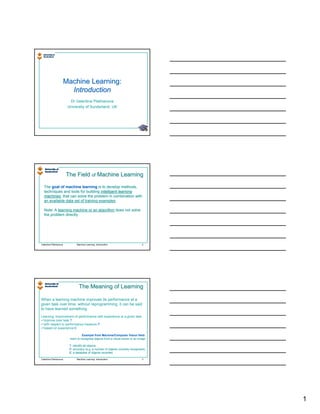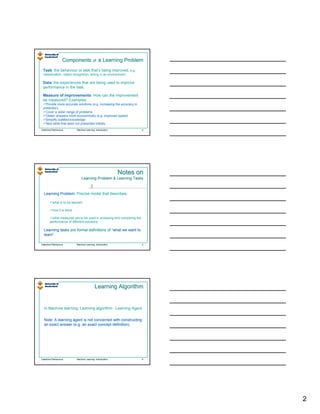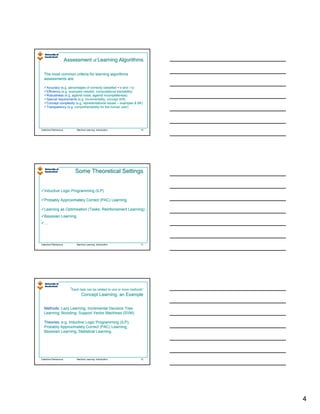Machine Learning: Machine Learning: Introduction Introduction
- 1. Machine Learning: Introduction Dr Valentina Plekhanova University of Sunderland, UK The Field of Machine Learning The goal of machine learning is to develop methods, techniques and tools for building intelligent learning machines, that can solve the problem in combination with machines, examples. an available data set of training examples. Note: A learning machine or an algorithm does not solve the problem directly. Valentina Plekhanova Machine Learning: Introduction 2 The Meaning of Learning When a learning machine improves its performance at a given task over time, without reprogramming, it can be said to have learned something. Learning: improvement of performance with experience at a given task improve over task T with respect to performance measure P based on experience E Example from Machine/Computer Vision field: learn to recognise objects from a visual scene or an image T: identify all objects P: accuracy (e.g. a number of objects correctly recognised) E: a database of objects recorded Valentina Plekhanova Machine Learning: Introduction 3 1
- 2. Components of a Learning Problem Task: the behaviour or task that’s being improved, e.g. classification, object recognition, acting in an environment. Data: the experiences that are being used to improve performance in the task. Measure of improvements: How can the improvement be measured? Examples: Provide more accurate solutions (e.g. increasing the accuracy in prediction) Cover a wider range of problems Obtain answers more economically (e.g. improved speed) Simplify codified knowledge New skills that were not presented initially Valentina Plekhanova Machine Learning: Introduction 4 Notes on Learning Problem & Learning Tasks Learning Problem: Precise model that describes: Problem what is to be learned how it is done what measures are to be used in analysing and comparing the performance of different solutions. Learning tasks are formal definitions of “what we want to “what learn”. learn”. Valentina Plekhanova Machine Learning: Introduction 5 Learning Algorithm In Machine learning: Learning algorithm - Learning Agent. Note: A learning agent is not concerned with constructing an exact answer (e.g. an exact concept definition). Valentina Plekhanova Machine Learning: Introduction 6 2
- 3. Learning Feedback Learning feedback can be provided by the system environment or the agents themselves. Supervised learning: specifies the desired activities/objectives of learning – feedback from a teacher Unsupervised learning: no explicit feedback is provided and the objective is to find out useful and desired activities on the basis of trial-and-error and self-organisation processes – a passive observer Reinforcement learning: specifies the utility of the actual activity of the learner and the objectives is to maximise this utility – feedback from a critic [ Sen & Weiss, 1999 ] Valentina Plekhanova Machine Learning: Introduction 7 Ways of Learning Rote learning, i.e. learning from memory; in a mechanical way Learning from examples and by practice Learning from instructions/advice/explanations Learning by analogy Learning by discovery … Valentina Plekhanova Machine Learning: Introduction 8 Inductive & Deductive Learning Inductive Learning: Reasoning from a set of examples Learning to produce a general rules. The rules should be applicable to new examples, but there is no guarantee that the result will be correct. Deductive Learning: Reasoning from a set of known Learning facts and rules to produce additional rules that are guaranteed to be true. Valentina Plekhanova Machine Learning: Introduction 9 3
- 4. Assessment of Learning Algorithms The most common criteria for learning algorithms assessments are: Accuracy (e.g. percentages of correctly classified +’s and –’s) Efficiency (e.g. examples needed, computational tractability) Robustness (e.g. against noise, against incompleteness) Special requirements (e.g. incrementality, concept drift) incrementality, Concept complexity (e.g. representational issues – examples & BK) Transparency (e.g. comprehensibility for the human user) Valentina Plekhanova Machine Learning: Introduction 10 Some Theoretical Settings Inductive Logic Programming (ILP) Probably Approximately Correct (PAC) Learning Learning as Optimisation (Tasks: Reinforcement Learning) Bayesian Learning … Valentina Plekhanova Machine Learning: Introduction 11 “Each task can be related to one or more methods” Concept Learning: an Example Methods: Lazy Learning; Incremental Decision Tree Methods: Learning; Boosting; Support Vector Machines (SVM). Theories: e.g. Inductive Logic Programming (ILP); Theories: Probably Approximately Correct (PAC) Learning; Bayesian Learning; Statistical Learning. Valentina Plekhanova Machine Learning: Introduction 12 4
- 5. Summary A Model of Learning: Key Aspects Learner: who or what is doing the learning, e.g. an algorithm, a computer program. Domain: what is being learned, e.g. a function, a concept. Goal: why the learning is done. Representation: the way the objects to be learned are represented. Algorithmic Technology: the algorithmic framework to be used, e.g. decision trees, lazy learning, artificial neural networks, support vector machines. [Sen & Weiss, 1999 ] Valentina Plekhanova Machine Learning: Introduction 13 Summary A Model of Learning: Key Aspects Information Source: the information/training data the program uses for learning, e.g. positive/negative examples, feedback from actions. Training/Learning Scenario: the description of the learning process, e.g. interactive, supervised / unsupervised, etc. Prior Knowledge: what is known in advance about the domain, e.g. about specific properties of the concepts to be learned. Success Criteria: the criteria for successful learning. Performance: e.g. the amount of time, space and computational power needed in order to learn a certain task. [Sen & Weiss, 1999 ] Valentina Plekhanova Machine Learning: Introduction 14 5


![Learning Feedback
Learning feedback can be provided by the system
environment or the agents themselves.
Supervised learning: specifies the desired activities/objectives of
learning – feedback from a teacher
Unsupervised learning: no explicit feedback is provided and the
objective is to find out useful and desired activities on the basis of trial-and-error
and self-organisation processes – a passive observer
Reinforcement learning: specifies the utility of the actual activity of
the learner and the objectives is to maximise this utility – feedback from a critic
[ Sen & Weiss, 1999 ]
Valentina Plekhanova Machine Learning: Introduction 7
Ways of Learning
Rote learning, i.e. learning from memory; in a mechanical way
Learning from examples and by practice
Learning from instructions/advice/explanations
Learning by analogy
Learning by discovery
…
Valentina Plekhanova Machine Learning: Introduction 8
Inductive & Deductive Learning
Inductive Learning: Reasoning from a set of examples
Learning
to produce a general rules. The rules should be
applicable to new examples, but there is no guarantee
that the result will be correct.
Deductive Learning: Reasoning from a set of known
Learning
facts and rules to produce additional rules that are
guaranteed to be true.
Valentina Plekhanova Machine Learning: Introduction 9
3](https://image.slidesharecdn.com/machine-learning-machine-learning-introduction-introduction807/85/Machine-Learning-Machine-Learning-Introduction-Introduction-3-320.jpg)

![Summary
A Model of Learning: Key Aspects
Learner: who or what is doing the learning, e.g. an algorithm, a
computer program.
Domain: what is being learned, e.g. a function, a concept.
Goal: why the learning is done.
Representation: the way the objects to be learned are represented.
Algorithmic Technology: the algorithmic framework to be used, e.g.
decision trees, lazy learning, artificial neural networks, support vector
machines. [Sen & Weiss, 1999 ]
Valentina Plekhanova Machine Learning: Introduction 13
Summary
A Model of Learning: Key Aspects
Information Source: the information/training data the program uses for
learning, e.g. positive/negative examples, feedback from actions.
Training/Learning Scenario: the description of the learning process, e.g.
interactive, supervised / unsupervised, etc.
Prior Knowledge: what is known in advance about the domain, e.g.
about specific properties of the concepts to be learned.
Success Criteria: the criteria for successful learning.
Performance: e.g. the amount of time, space and computational power
needed in order to learn a certain task.
[Sen & Weiss, 1999 ]
Valentina Plekhanova Machine Learning: Introduction 14
5](https://image.slidesharecdn.com/machine-learning-machine-learning-introduction-introduction807/85/Machine-Learning-Machine-Learning-Introduction-Introduction-5-320.jpg)